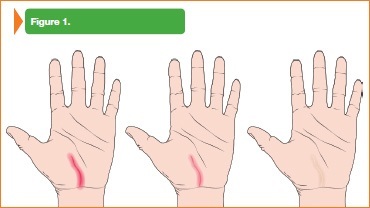
Scar Management

Scar formation is a normal response following any injury or surgery; it is the way the body heals injured structures. An active scar may be red, raised, firm, and thick. Scar tissue may involve only the superficial skin, or it may involve the deeper tissues beneath the skin, including nerves and tendons. Scars can become overly sensitive and can limit motion and function.
Scar Healing
After the skin and deeper tissues have healed, the scar goes through four different stages of healing:
- Hemostasis (bleeding stops)
- Inflammation
- Repair
- Remodeling (or maturation) of the scar tissue
By the time the skin heals within seven (arm/forearm) to 10-12 days (hand/fingers), the first two stages have already taken place. Although the initial skin scar may be minimal, the scar will often enlarge and become more reddened over the following 4-6 weeks. An active scar is typically red, raised, firm and thick. Sometimes this change is misinterpreted by the patient as possible infection. However, in the normally-healing wound, there is no drainage or blistering. The outermost layer often loosens with the deeper layers remaining intact and, while this can give the appearance of “opening up,” it is normal.
Following the swelling/reddening phase, the wound gradually reduces in size and color over the next 2-3 months (Figure 1). Later the scar becomes soft and has a more natural color in most individuals.
Treatment
Your hand surgeon or hand therapist may recommend a variety of treatments once your injury is healed, incisions are closed, and sutures are removed. Timing of scar treatments varies depending on the type of injury or surgery. Scar management treatments may include:
- Scar massage can help reduce sensitivity and loosen any adhesions to deeper structures, especially tendons and joints. Scar massage helps to produce a scar that is smooth and moveable.
- Early controlled exercise programs can prevent stiffness of nearby joints and keep tendons gliding under the skin.
- Silicone gel can be placed on the scar in sheets or in liquid form for adults (often at night), and taping/wrapping of the scar can help reduce swelling and tension.
- Massage, vibration and rubbing the scars with various textures can help overly sensitive scars, which occur when the nerves in the skin and deeper tissues are affected by the injury or surgery. The scar may also be submerged in various slightly abrasive particles. The goal of this treatment is to reduce scar sensitivity and to help the skin and nerves become tolerant of the normal forces of everyday living. This process of “desensitizing” the scar can take up to 4 months and is best initiated as soon as the skin and repaired tissues have adequately healed.
- Injections or surgery for special scar problems, such as burn scars/contractures or keloids that require more vigorous treatment. Special gloves or topical treatment may be recommended for burn scars.
Some scars take up to a year to become completely mature. Therefore, some scar revisions may not be offered until a year after injury/surgery. Scars have completed the healing process when they are light in color, smooth, supple, and no longer sensitive to touch. While scars are young and in the healing phase (pink, red, raised, thick, and sensitive) they should be protected from the sun as sunlight can damage the fragile scar and ultimately darken its color.


 Co-Director
Co-Director



